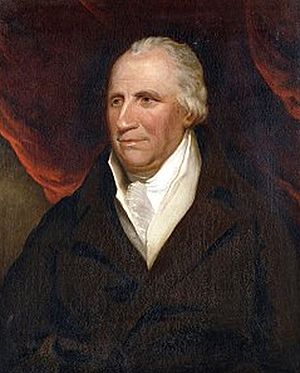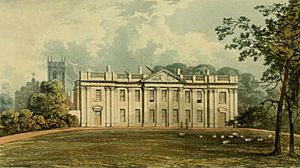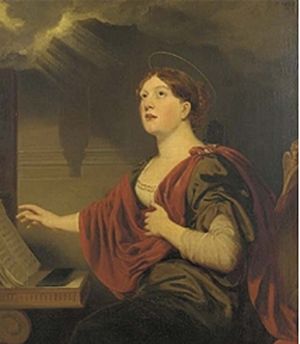Sutton Scarsdale Hall facts for kids
Quick facts for kids Sutton Scarsdale Hall |
|
|---|---|

View of the hall from the eastern lawn
|
|
| General information | |
| Architectural style | Georgian mansion |
| Location | Sutton Scarsdale |
| Town or city | Chesterfield, Derbyshire |
| Country | United Kingdom |
| Coordinates | 53°12′55″N 1°20′23″W / 53.215328°N 1.339663°W |
| Construction started | 1724 |
| Completed | 1729 |
Sutton Scarsdale Hall is a beautiful old country house in Sutton Scarsdale, near Chesterfield, Derbyshire. It's a Grade I listed building, which means it's very important historically. Today, it stands as a grand ruin, showing off its Georgian style.
Contents
A Look at the Hall's Long History
The land where Sutton Scarsdale Hall stands has a very long history. It was once part of an Anglo-Saxon estate owned by a person named Wulfric Spott. He passed away in 1002, leaving the estate to Burton-on-Trent Abbey. Later, in the famous Domesday Book (a big survey of England from 1086), the estate was owned by Roger de Poitou.
Who Owned the Estate?
Over the years, the ownership of Sutton Scarsdale changed many times. In 1225, King Henry III gave the land to Peter de Hareston. But by 1401, a family called Leke, from Gotham, bought it.
A later John Leke was made a knight by King Henry VIII. His son, Francis Leke, was given special titles by kings. First, King James I made him a Baronet in 1611. Then, King Charles I made him the Earl of Scarsdale in 1640.
The Hall During the English Civil War
When the English Civil War began, Francis Leke supported King Charles I. His side was called the Cavaliers. The Hall was made stronger to protect it. This was important because Bolsover Castle nearby supported the other side, called the Roundheads.
A group of 500 Parliamentarian soldiers, led by Sir John Gell, surrounded the Hall. Leke fought back, but the house was eventually taken. He was captured. After the war, the estate was taken over by Oliver Cromwell's forces. Francis Leke had to pay a huge fine of £18,000 for supporting the King.
Building the Grand House
The building you see today is thought to be the fourth or fifth house built on this spot. In 1724, Nicholas Leke, 4th Earl of Scarsdale, decided to build a grand new house. He hired a famous architect named Francis Smith. Smith designed a beautiful Georgian mansion with lovely gardens. He even used parts of the older buildings in his new design.
Inside the Mansion
Sutton Scarsdale Hall was once as grand and fancy as Chatsworth House. Inside, it had amazing features:
- Walls covered in beautiful oak panels.
- Fancy stucco plasterwork made by skilled Italian artists, Francesco Vassalli and the Artari brothers.
- Fireplaces carved from marble and a special stone called Blue John. These were in the style of Robert Adam, a famous designer.
- A grand mahogany staircase.
New Owners Over Time
After the 4th Earl died, a Member of Parliament named Godfrey Clarke bought the estate in 1740. Later, after his son passed away in 1774, Walter Butler, 1st Marquess of Ormonde became the owner through marriage.
After Butler's death in 1824, Richard Arkwright Junior bought the Hall. He was famous for his work with Cromford Mill. William Arkwright, another family member, was a very important person in Derbyshire in 1890.
The Arkwright Family at Sutton Scarsdale Hall
Richard Arkwright Junior (1755–1843) bought Sutton Scarsdale Hall in 1824. He was the son of Sir Richard Arkwright, who invented the water frame. This invention was very important for the cotton industry. Richard Junior was also very good at business, just like his father. He made a lot of money in the cotton trade.
Richard Arkwright Junior's Life
Around 1780, Richard Junior married Mary Simpson. They had eleven children together. When his father died in 1792, Richard inherited a large fortune. He then decided to sell most of his cotton mill businesses. Instead, he focused on buying property and working in banking. He became incredibly wealthy. When he died in 1843, he was said to be the richest commoner in England.
Robert Arkwright and His Wife
After Richard Junior's death, his son Robert Arkwright (1783–1859) inherited Sutton Scarsdale Hall. In 1805, Robert married an actress named Frances Crawford Kemble. She was part of a famous acting family. At first, his family was not happy about this marriage.
However, Frances turned out to be a wonderful hostess. She quickly made friends with important people. She was also a talented music writer, and some of her songs are still known today. Her aunt was the famous actress Sarah Siddons. Frances often had dinner with Robert's parents when they were in London.
Later Arkwright Owners
When Robert died in 1859, his son, Reverend Godfrey Harry Arkwright, inherited the Hall. Godfrey was born in 1814. He went to famous schools like Eton and Trinity. He was married twice and had six children.
His oldest son was Francis Arkwright. Francis inherited Sutton Scarsdale when his father Godfrey died in 1866. Francis was born in 1846 and also went to Eton. He married Louisa Milbank, but she sadly died in 1873. They had one daughter. He later married Evelyn, but they had no children.
Francis became a Member of Parliament in 1874 and served until 1880. In 1882, he moved to New Zealand. Around this time, he left Sutton Scarsdale Hall in the care of his cousin, William Arkwright. William inherited the property when Francis died in 1915, as Francis had no male heir.
William Arkwright was born in 1857. He was very interested in breeding dogs. He even wrote a book called The Pointer and His Predecessors. In 1919, William decided to sell Sutton Scarsdale Hall and the rest of the estate at an auction.
Becoming a Ruin
After being neglected for many years, a group of local business people bought the estate in November 1919. They took many valuable parts from the house. They even removed the roof in 1920! Some parts of the building were sent to the United States.
For example, the oak panels from one room were bought by a newspaper owner named William Randolph Hearst. He wanted to use them in his grand home, Hearst Castle. After being stored for many years in New York City, these panels were bought by a film company. They used them as a set in movies during the 1950s. Another set of panels is now in the Philadelphia Museum of Art.
In 1946, Sir Osbert Sitwell from Renishaw Hall bought the estate. He wanted to save what was left of the Hall as a beautiful ruin. Today, English Heritage looks after Sutton Scarsdale Hall. They are working to preserve it, so people can still visit and learn about its history.
Images for kids













